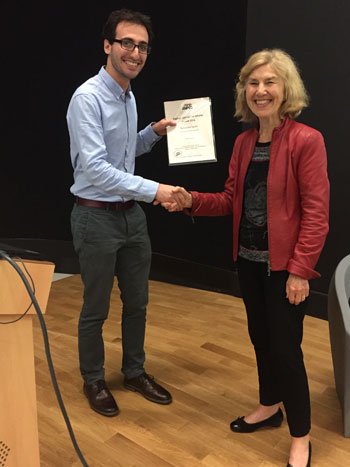Entrants for the Early Career Scholar Award for 2016 were uniformly excellent showing the rich set of talents of the younger ISHPES scholars. There were 9 interesting and well written papers in all from a number of countries, demonstrating the global reach of our organization.
The panel read each paper, assigned marks and then discussed the results, coming to a difficult conclusion given the high quality of the essays.
Research papers were submitted by Martin Friis Andersen, Liam Dyer, Kalle Rantala, Carolina Jubé, Benjamin Sacks , Georgia Cervin, Samantha White, Pierre White, Karolena Jamnik and they covered a wide range of extremely interesting and well researched sport history related topics
| The winner was BENJAMIN SACKS. He is a PhD candidate in History at the University of Western Australia (UWA) who submitted “A Footnote to Sport History: Twenty Years of Cricket, Conflict and Contestation in Samoa, 1880-1900”. This is an excellent paper examining sports, especially cricket, in the contested space of Samoa in a colonial contact zone — it is well documented, cleverly theorized and beautifully written.
Born in South Africa and raised in New Zealand and Australia, Sacks received BA and BEd degrees from UWA before pursuing postgraduate studies. His research interests in the field of sport history include the diffusion of sport through empire, the indigenisation of foreign sporting practices and the role of sport in propagating race- and gender-based discourses. In May 2016 he was awarded the Gunson Essay Prize in Pacific History for his paper entitled “‘Running Away With Itself’: Missionaries, Islanders and the reimagining of recreation in Samoa, 1830-1939”. The same essay has also been shortlisted for the Australian Historical Association’s Jill Roe Prize, awarded for the best unpublished article-length work produced by a postgraduate student in Australia. |
 |
Abstract: During the late-nineteenth century, the New Imperialism increasingly made much of the world into what Louise Pratt terms ‘contact zones’ — “social spaces where cultures meet, clash and grapple with each other, often in contexts of highly asymmetrical relations of power”. Sport was one of the most visible spaces where this process took place. This paper uses the example of cricket in Samoa to demonstrate how different groups sought to control the meaning and function of sport during a time of great uncertainty. To do so, it presents evidence drawn from local newspapers, diaries and archival sources from the period between cricket’s introduction circa 1880 and the partition of the islands in 1900. Almost as soon as they began playing the sport, Samoans radically altered cricket’s method and meaning and recast it as the distinctive Samoan game of kirikiti. This initial act of appropriation established the cricket pitch as a ‘contested space’ between Samoans and foreigners, who were wary of kirikiti’s association with ‘disruptive’ Samoan politics and ‘wasteful’ customary exchange. As was the case in Samoa more generally, however, the struggle over cricket was not neatly divided between Samoans and foreigners. While missionaries, planters and commercial interests portrayed the game as a threat to decency and prosperity, others – notably sailors and persons seeking to further British influence – greeted it with enthusiasm. The contours of Great Power rivalry also shaped cricket’s meaning for Samoans, who frequently used the game to signal alignment with or against one or another Western power. Finally, Samoa’s growing ‘mixed-race’ community saw cricket and kirikiti as a means of confirming their place in both the Samoan and European ‘worlds’. The paper will hence conclude that cricket in Samoa was an inherently ‘contested space’ that reflected the complexities and blurred boundaries created by imperial expansion.
Martin Friis Andersen’s paper was a very close runner up. His well argued and documented paper was entitled “Live from London Radio at the 1948 Olympics as a Place of Memory”. In his paper he takes us down into the Danish living room with discussions of Olympic sport experiences heard over radio broadcasts from the time.
Georgia Cervin’s paper on “Dreamboats and Amazons: New York Times Representations of Female Athletes in the Brundage Era” was also a close runner up, focused on the framing of American and Russian sportswomen by the New York Times.

